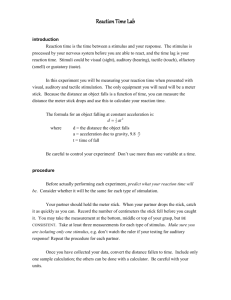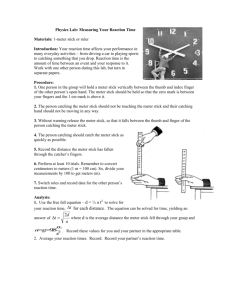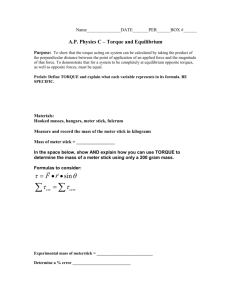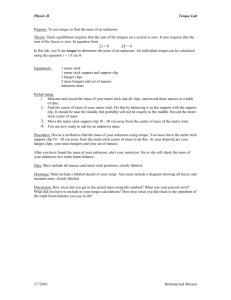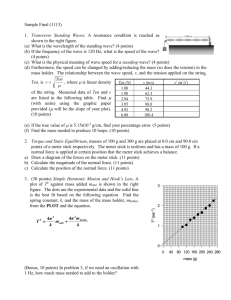Nervous System Lab
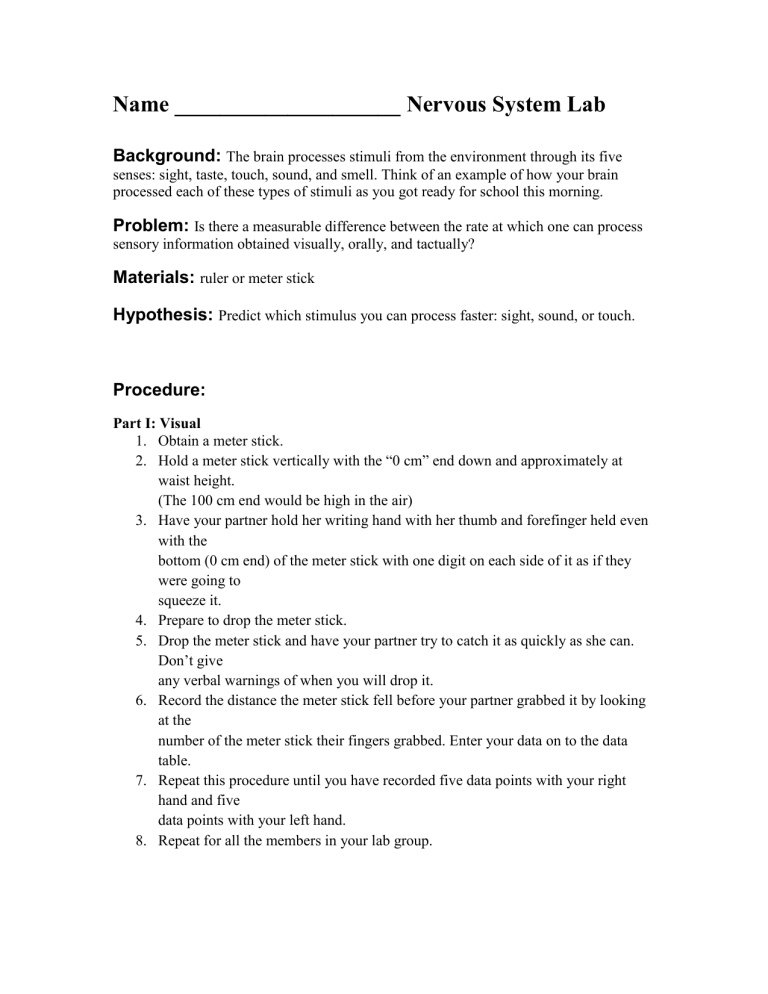
Name ____________________ Nervous System Lab
Background:
The brain processes stimuli from the environment through its five senses: sight, taste, touch, sound, and smell. Think of an example of how your brain processed each of these types of stimuli as you got ready for school this morning.
Problem:
Is there a measurable difference between the rate at which one can process sensory information obtained visually, orally, and tactually?
Materials:
ruler or meter stick
Hypothesis:
Predict which stimulus you can process faster: sight, sound, or touch.
Procedure:
Part I: Visual
1.
Obtain a meter stick.
2.
Hold a meter stick vertically with the “0 cm” end down and approximately at waist height.
(The 100 cm end would be high in the air)
3.
Have your partner hold her writing hand with her thumb and forefinger held even with the bottom (0 cm end) of the meter stick with one digit on each side of it as if they were going to squeeze it.
4.
Prepare to drop the meter stick.
5.
Drop the meter stick and have your partner try to catch it as quickly as she can.
Don’t give any verbal warnings of when you will drop it.
6.
Record the distance the meter stick fell before your partner grabbed it by looking at the number of the meter stick their fingers grabbed. Enter your data on to the data table.
7.
Repeat this procedure until you have recorded five data points with your right hand and five data points with your left hand.
8.
Repeat for all the members in your lab group.
Part II: Auditory
9.
Repeat the procedure above, but this time have the “catcher” close his or her eyes.
The dropper indicates when the meter stick is dropped by saying “Now”. It is very important that the dropper says, “Now” exactly when the meter stick is dropped.
10.
Record the distance the meter stick fell.
11.
Repeat the exercise for the other partners.
Part III: Tactile
12.
This time, the catcher closes his or her eyes again, and the dropper indicates the meter stick is being dropped by tapping the catcher on the shoulder.
13.
Record the distance the meter stick fell.
14.
Repeat the exercise for the other partners.
Data:
Use the following table to collect your data.
Response Scores – Distance (cm)
Visual Stimulus Auditory Stimulus Tactile Stimulus
Person Person Person
1 2 3 4 1 2 3 4 1 2 3 4
1.
Add to your data table the average response score for each person for each type of stimulus and the average for the group for each type of stimulus
2.
Create a bar graph from your data. Make a key for type of stimulus.
Ex. Visual = Red; Auditory = Blue; Tactile = Green
(Use separate graph paper and attach it to the lab)
Questions:
1.
Which type of stimulus did your group respond to the best?
2.
Why do you think that is?
3.
Which type of stimulus did your group respond to the worst?
4.
Why do you think that is?
5.
Which hand is your writing hand?
6.
Did you catch the ruler faster with your left or right hand? Why might this be so?
7.
Why did you run several trials for each hand?
8.
Explain why a message moving along nerve pathways takes time.
9.
How might the results change if a 70 years old did this experiment? Why?
10.
What is the definition of reaction time?
11.
What are quick, protective reactions within your nervous system called?
12.
Was your hypothesis supported? Support your answer with your data.
13.
Were there any sources of error?
14.
What did you learn in this experiment?

